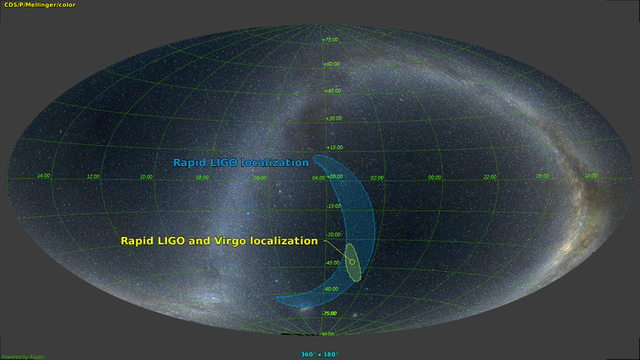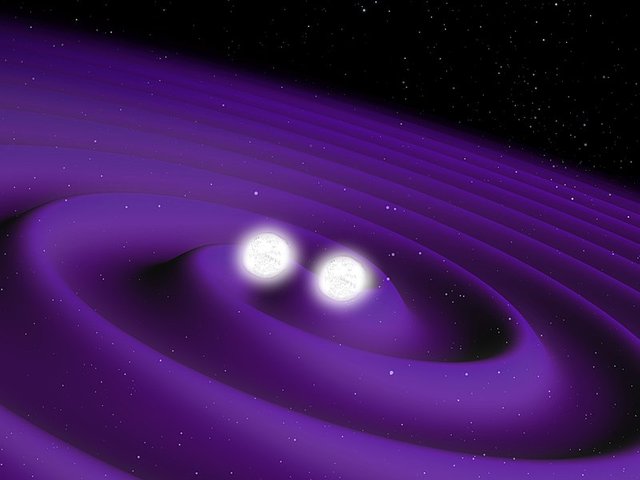New Gravitational Waves Found by LIGO and Virgo

In August 2017, astronomers again managed to detect the gravitational wave signal coming from a pair of colliding black holes. The collision was observed on Aug. 14 at 10:30:43 UTC, by the Gravitational Wave Observatory (LIGO) Laser Interferometer detector located in Livingston, Louisiana, and Hanford, Washington, and the Virgo detector located near Pisa, Italy. This gravitational wave is called GW170814.
Astronomers estimate that GW170814 is produced by a black hole with a mass of 31 times the mass of the Sun and 25 times the mass of the Sun colliding with each other and joining. This event occurs at a distance of 1.8 billion light-years from Earth and produces a new black hole with a mass 53 times the mass of the Sun. This means about 3 times the mass of the lost sun is released in the form of gravitational waves when the merging process occurs.
Keep in mind that this is the first time gravitational waves are detected by three different detectors. This makes the positioning of the gravitational waves in the sky more accurate. As an illustration, the position of GW170814 calculated by the collaboration between LIGO and Virgo is 10 times more accurate than that specified by LIGO alone. Improving the measurement accuracy is important because in the case of collisions between compact items such as black holes or neutron stars, it is expected to produce electromagnetic radiation that accompanies gravitational waves. Thus, we can further observe the event by using optical telescopes, radios, or even X-rays.
How Are Gravity Waves Formed?
Gravitational waves have actually been predicted by Albert Einstein in his general theory of relativity in 1916. Einstein shows mathematically that massive objects accelerating like neutron stars or orbiting black holes can interfere with space-time to form a wave. It's like when you throw rocks into a puddle, then you see the ripples or waves formed on the water's surface. Gravitational waves can propagate at the speed of light and carry important information about events that produce them.
Gravitational waves can be generated by catastrophic events such as colliding black holes, a collapse of star cores (supernovas), neutron or white dwarf interchanges, rotational shifts of neutron stars not perfectly spherical, and the rest of the gravitational waves generated by the birth of our universe.
Although gravitational waves had predicted its existence in 1916, its observational evidence was only discovered in 1974. At that time, two astronomers working at the Arecibo radio observatory found an orbiting double pulsar. Through 8 years of observation, they found that the period of the double pulsar orbit is changing faster. This happens because the two approach each other and release the gravitational waves according to the general theory of relativity.
Since then, astronomers have studied many pulsars to gain more proof until finally declared that gravitational waves are true. However, this confirmation is indirect because of the observed changes in the pulsar's orbital period, not the emission of its gravitational waves.
Finally, on September 14, 2015, LIGO for the first time managed to detect space-time distortions caused by gravitational waves. This gravitational wave is generated by a collision between two black holes 1.3 billion light years away from us. The discovery by LIGO and Virgo is proof that we have been one step ahead in understanding the gravitational waves in the universe. In the foreseeable future, there is hope that more gravitational waves will be detected and lead us to an unexpected discovery.
best regard @t4r1
Reference :
https://www.space.com/36407-the-mystery-of-how-black-holes-collide-and-merge-is-beginning-to-unravel.html
http://www.lsu.edu/mediacenter/news/2016/06/15wavesdetected.eb.php
https://phys.org/news/2016-06-gravitational-pair-colliding-black-holes.html
https://news.uchicago.edu/article/2016/06/15/gravitational-waves-detected-second-pair-colliding-black-holes
https://www.nytimes.com/2017/09/27/science/black-holes-collision-ligo-virgo.html
https://stfc.ukri.org/news-events-and-publications/features/gravitational-waves-everything-you-need-to-know/

Hi, I found some acronyms/abbreviations in this post. This is how they expand:
Congratulations! This post has been upvoted from the communal account, @minnowsupport, by abumuhammad from the Minnow Support Project. It's a witness project run by aggroed, ausbitbank, teamsteem, theprophet0, someguy123, neoxian, followbtcnews, and netuoso. The goal is to help Steemit grow by supporting Minnows. Please find us at the Peace, Abundance, and Liberty Network (PALnet) Discord Channel. It's a completely public and open space to all members of the Steemit community who voluntarily choose to be there.
If you would like to delegate to the Minnow Support Project you can do so by clicking on the following links: 50SP, 100SP, 250SP, 500SP, 1000SP, 5000SP.
Be sure to leave at least 50SP undelegated on your account.